Are you planning on learning how to make your own sewing patterns? If so, you’ll be wondering what tools are required for pattern making.
This list of just fourteen tools are the very essentials you will need when getting started drafting patterns.
I’ve even included a video at the end of this post of the 8 pattern making tools that I use daily when making sewing patterns!
Have a read, and let me know what you think!
Some of the links in this article are affiliate links. This means that I may receive a fee at no extra cost to you if you purchase a recommended product.

1. Pattern Making Paper
Without paper, there is no pattern! Pattern making paper is sold in different styles. Plain, squared or dot and cross. I like the plain version, which I buy in a HUGE roll from Morplan in London.

Why is dedicated Pattern making paper so important? It’s the translucency pattern making paper offers. If you are drafting patterns, you’ll need to be tracing sections off. Pattern making paper offers this translucency.
Other paper will also work, such as printer paper above, but you will struggle if anything needs tracing off due to the heavier weight of the paper.
2. Pattern Master / Fashion Ruler
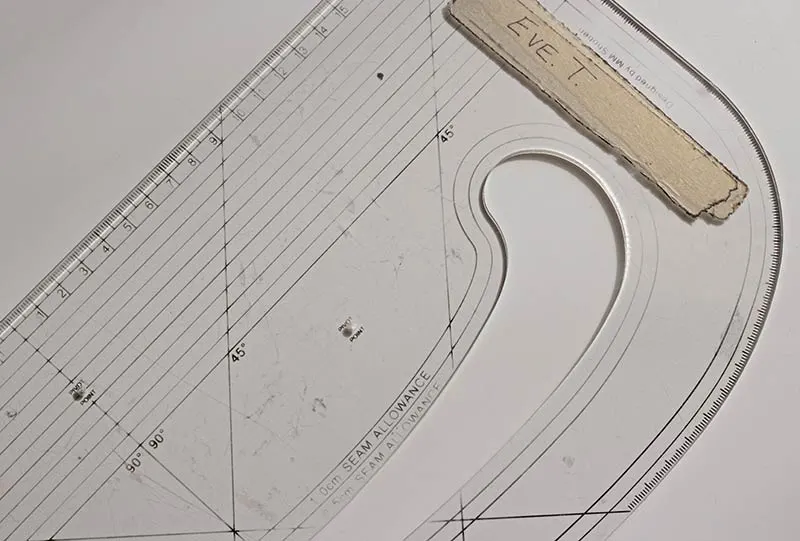
I LOVE my pattern master. I have a habit of sitting on mine, snapping it in half, which isn’t quite so great! This is a version designed by Martin Shoben and sold exclusively via Morplan in London UK. There is a non-Shoben version of the pattern master here.
There’s a newer thinner version of the Pattern Master from Shoben, and it’s called the Fashion Curve.

It takes some getting used to as it is longer, narrower, thinner and more flexible. I have had one for a couple of years but I always reach for my old trusty and more solid pattern master first!
If both look scary to you, you can always use the classic French curve. My one below is old and knackered, but mostly from being carried with me when travelling.
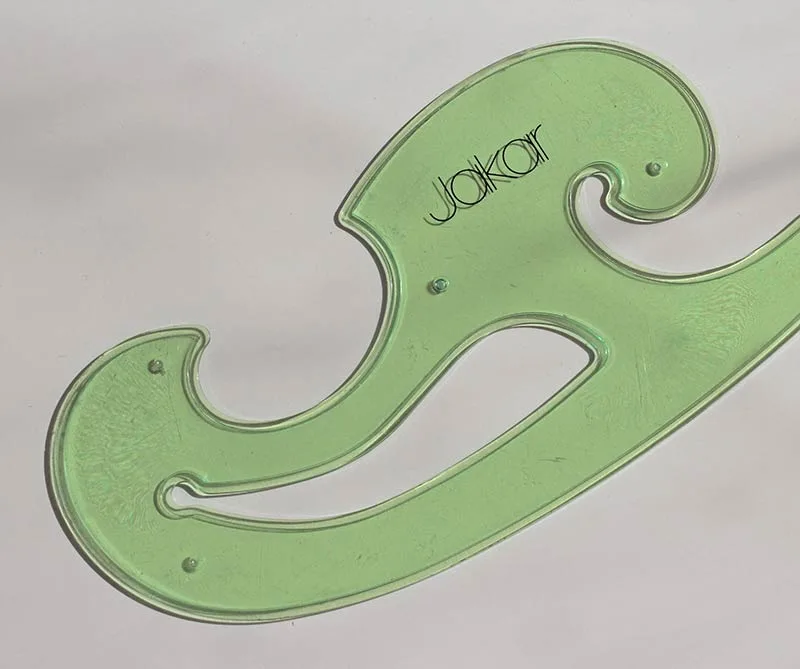
I have been known to take my large fashion curve on trains and planes when travelling back to the UK. Why? Well, I like to have something with me for when inspiration strikes!
RELATED CONTENT:
The three best French curve rulers for sewing and pattern making
3. Awl

My awl comes in very handy. It is mostly useful for when I am pivoting my patterns around, pivoting darts and other fabric suppression bits around the pattern.
The point of an awl is quite sharp – it is like a spike – and much thicker than a pin! – which also makes it super handy when transferring markings from a master pattern to a working pattern, or from a pattern to fabric.

4. Pattern Drill

A pattern drill is a great pattern making tool for marking in the positions of darts, pleats and gathers.

A pattern drill works like a special hole punch. You push onto it to ‘drill’ a hole into the pattern, leaving a perfect circle cutout behind – similar to a hole punch.
Only used on paper or card patterns, the holes allow you to mark on the fabric where key points are, such a patch pockets to darts.
You’ll need to open the drill periodically to empty the cut outs from within!

Pattern drills come with holes of different sizes. I have two, and they’re a few millimetres difference in the sizing of the hole. If you cannot find one like mine, there’s a pattern drill as part of this set which has good reviews!
You can learn more about how a pattern drill works here!
5. Tracing Wheel

A tracing wheel is a pattern maker’s best friend. An essential pattern making tool, I use it to trace self-drafted blocks, commercial sewing patterns and even clothes to create new pattern ideas from.
They’re also very useful for truing pattern pieces after you’ve done some dart manipulation.
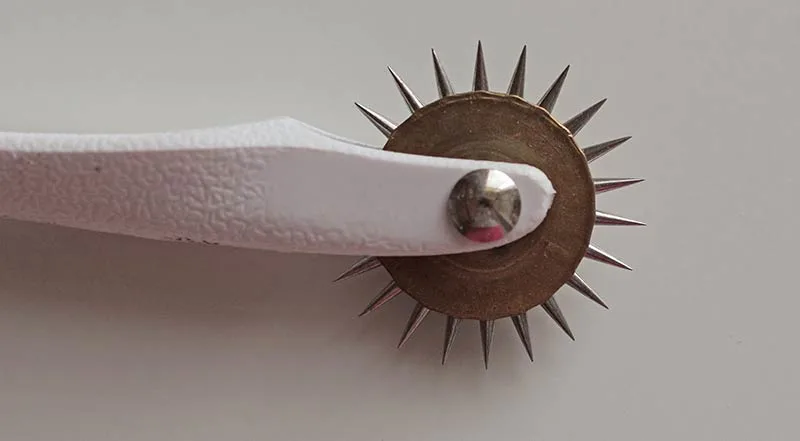
It’s hard to find this spike version now, but this tracing wheel is close enough!

Watch out for the spikes though – I have drawn blood with the one above!
Learn more about what a tracing wheel is and how to use them here!
6. Pattern Notcher
Pattern notchers are used to mark in notches in your paper and card patterns. They keep your notch markings consistent and more easily recognisable.

I think these might have been the first proper tool I splashed out on when I was just learning pattern making as a fashion student. I bought these from Morplan for well over £20, and they have lasted me well.
This pair of pattern notchers will also get the job done but do read more about using pattern notchers here!
7. Pattern / Paper Scissors

One of my all time favourite purchases from Morplan as a fashion student was this pair of paper pattern scissors.
When you’re learning pattern making, you’ll want a great pair of paper scissors dedicated to pattern making. The best is a short blade for better control as seen in my scissors.

If you aren’t in the UK, these scissors will also work for cutting paper, though they’re not short blades like mine.
Learn more about the different cutting tools used in sewing here.
8. Flexible Ruler

A flexible ruler is a great tool for anyone that wants to make patterns. It’s a bendy ruler, which you can bend into shape, but it will hold its shape once removed so that you can draw around the curve created.
I use it for ‘tracing’ the shape of crotch curves on pant patterns. My current Flexi ruler doesn’t have measurement markings on it, but I have an rubber band at the centre which I align with my crotch point, and then I use a pencil to mark on the ruler the points as needed.
I recommend you grab this flexible curve ruler, as it has the measurements on it that you’ll need when pattern making!
9. Hard 2H or 4H Pencils
You know one thing that really bugs me? People who use the wrong tools. And the one thing you can go wrong with when it comes to pattern making tools? The wrong kind of pencil. Seriously.
This one is a BIG pet hate of mine!

It is so easy to get your hands on a decent 3H or 4H pencil. The reason they’re best? They are a HARD pencil. This means that when you mark a line with a nice sharp pencil, you will get a lovely sharp line.

- It won’t be wide and smudgey
- You’ll be able to see the right line you want to trace off
- It JUST MAKES SENSE! *nuff said*
These are some of the 4H pencils I use, and its a six pack – just in case you lose one! 😉
10. A One Metre Ruler

A metre ruler is a pattern making tool that you can’t really do without. I use mine for marking in long grain-lines when modifying my patterns, for adding long lines of seam allowance and when drafting pattern blocks.
This metre ruler has a handle attached for easier manoeuvring and is a great price too.
11. Fabric Tape Measure
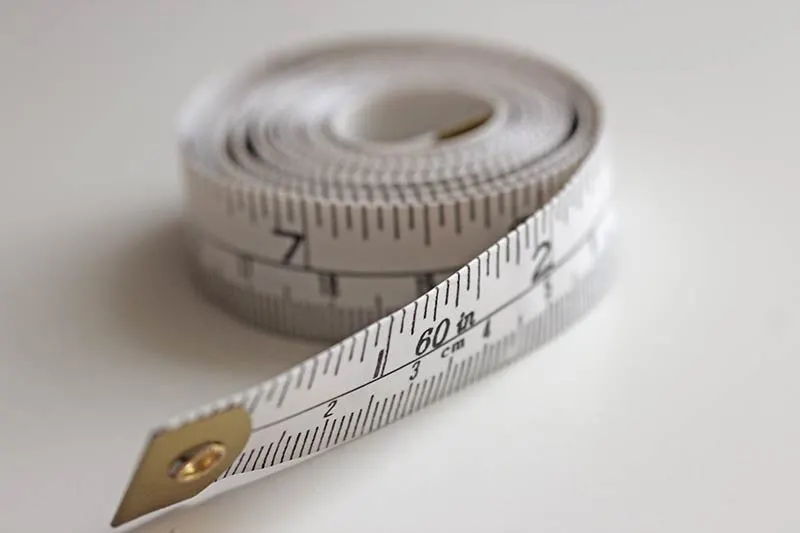
I have at least five tape measures near me in my sewing room. I have one in a portable kit for when I am out an about so that I can use it to ‘measure’ things – usually when I’m tucked in a changing room checking out the garment construction techniques used on current fashions!
I’ve mentioned it before, but it is really important that you use the same tape measure for a project. You’ll be amazed by how much some tape measure can stretch, or just be ‘wrong’.

The photo above is my old Morplan tape measure – notice how far the metal end of the tape measure hangs over the tape itself?
Make sure that you refresh your tape measure stash often – a stretched tape measure is a dodgy tape measure when it comes to drafting patterns!
12. Masking Tape

I love using masking tape. If you buy the non-tacky variety you’ll be able to peel it away when you’ve finished with a pattern piece.
I find it useful for temporarily attaching paper sections together, or holding garment pieces on paper before tracing them off.

I buy mine from Cass Art in the UK as it is the only one I have found which is non-tacky, which makes it easy to peel off without ripping my pattern paper. This masking tape in the US is low tack!
13. A Glue Stick
Good old Pritt Stick! This glue sick is an essential pattern making tool for me. I use it to temporarily hold things in place, to add extra paper when pivoting patterns, and for any slash and spread pattern making activity!
I can get through quite a few glue sticks in a week when pattern drafting, so often buy several Pritt sticks at a time to make sure I don’t run out!
14. A Dress Form

The dress stand or dress form is also known as a tailors dummy. Now, this CLEARLY isn’t an essential tool for when you’re just started out on your pattern making journey.
They are a HUGE investment, and so you should only make the investment when you feel ready and able to progress further with more advanced pattern making and draping techniques.
If you’ve been thinking about buying a dress form, have a look at my guide of the best dress forms first – I have an article dedicated to men looking for Male dress forms too. I’ve covered lots of points that you should consider before buying a dress form of your own!

The one in the above photo is MY PRECIOUS. I had her made to order from Kennett & Lindsell about 6 years ago when I decided it was time to invest, and it cost me almost £1200. Before that, I used an adjustable one, and that worked well for me. I love mine because she has collapsible shoulders.
Here are a couple of dress stands that you could look into:
Remember, it is important to get the right dummy for your needs. The home sewer who is making clothes for themselves, will do well with an adjustable dummy, while the fashion student / designer will do better with a fixed size dummy that they can then use as a basis for their designs.
Final Thoughts On Pattern Making Tools
At the end of the day, this list of pattern making tools consists of tools I personally cannot live without when pattern making.
I haven’t included any basic sewing tools such as dressmakers pins or fabric shears, because these aren’t essential to pattern making. And there are pattern makers out there who do not sew!
Let me know if you have a favourite tool for patternmaking, and if you’re excited to start pattern making yourself, pop over to this page of pattern making tutorials, this page of pattern drafting tutorials or learn about my favourite pattern making books here!
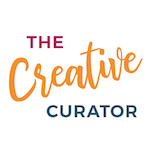


Jacinta
Monday 17th of June 2024
Thank you. Very interesting video.
Bob
Wednesday 19th of January 2022
I find washi tape is non-tacky and useful for lots of projects! They are fairly well availble in lots of places these days, and can come in wider widths too.
Eve Tokens
Monday 21st of February 2022
Oh, using washing tape instead of masking tape is a great tip Bob, especially with how much more easily it can be sourced! Thank you!
Temmy
Friday 31st of July 2020
Hello, please can the pattern master do the work of an arm hole curve, hip curve and pant curve ?
Eve Tokens
Thursday 10th of September 2020
Yes, most definitely! I use my pattern master for everything - but remember that freehand is also important to practice getting the lines smooth! :)
Jean Smethurst
Thursday 14th of May 2020
can you recommend the best book on sewing and pattern making/pattern altering /
Mimi
Monday 23rd of December 2019
Eve, Thank you for a great article. I am a novice sewer but want to learn to make pant patterns for myself and shirt patterns for my husband. We both have problems finding those items to fit correctly. Your article was just what I needed to get these projects headed in the right direction. Thanks again!